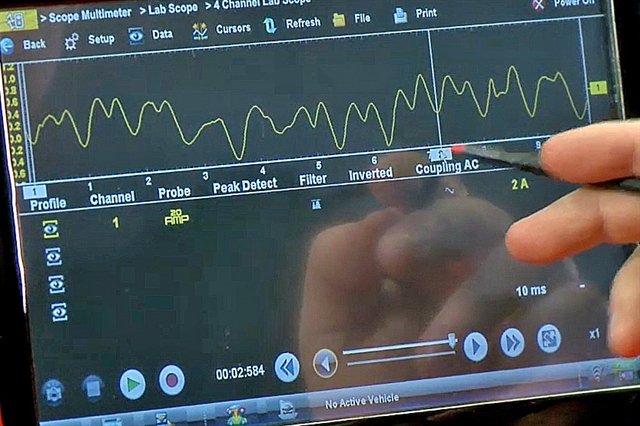Find out about a quick and easy way to help diagnose fuel pump issues by using your Snap-on lab scope and diagnostic software to generate readings for analysis.
Diagnosing a fuel pump problem can be pretty troublesome, especially if it's set back in the tank and you've got to drain the fuel tank before pulling the pump out.
Wouldn't it be nice to have a nice easy way to actually check the fuel pump from anywhere in the circuit and see how it's operating just by looking at the pattern on a lab scope?
There is in the Snap-on scan tools and diagnostic software – and it’s called the Fuel Pump Current Ramp Test.
First of all, connect your low amps probe to the vehicle’s circuit. You can remove a fuse, put a jumper wire in its place and put the amps probe around that wire.
You can use any part of the circuit to run this test so long as the amps probe is around one wire.
Set up your lab scope to display a two amp scale with a 10 millisecond window then crank the car over in order to generate a pattern for you to assess.

Diagnose fuel pump issues by using your Snap-on lab scope and diagnostic software to generate readings for analysis.
A fuel pump is basically just an electric motor with windings and brushes, and it also has commutators, which the brushes ride on – and that’s what transfers the electricity.
Almost every fuel pump you’re ever going to come across has eight commutators in it, so on your pattern you should be able to count out eight bumps, each one denoting one of the commutators in the motor and each set of eight being one revolution of the motor.
If you have at least eight bumps in a 10 millisecond window then you know it’s turning sufficiently fast as it’s hitting at least 6,000rpm.
Most regular fuel pumps are going to run at between 5,000 and 6,000rpm but if they drop to around 3,000rpm, you are going to run into some drivability issues.
You want to make sure that all of the bumps are nice and even. If they are not, that would indicate that the fuel pump is on its way out and should be replaced as soon as possible.
It doesn’t take long to hook up your lab scope and generate the readings so don’t overlook what is a quick and easy way to help diagnose fuel pump issues.
Date posted: 12 August 2019